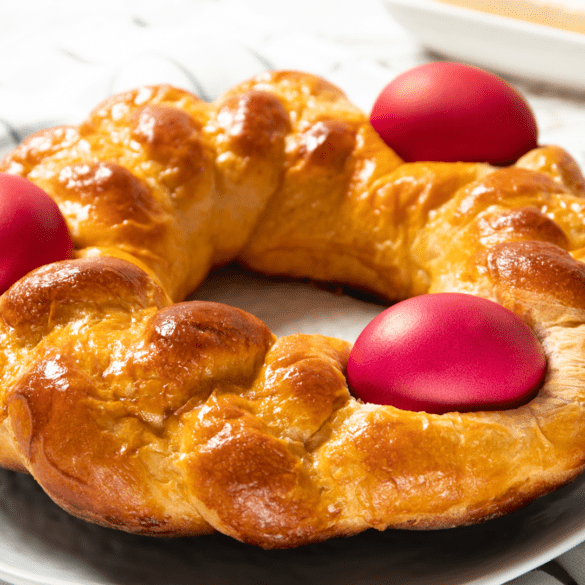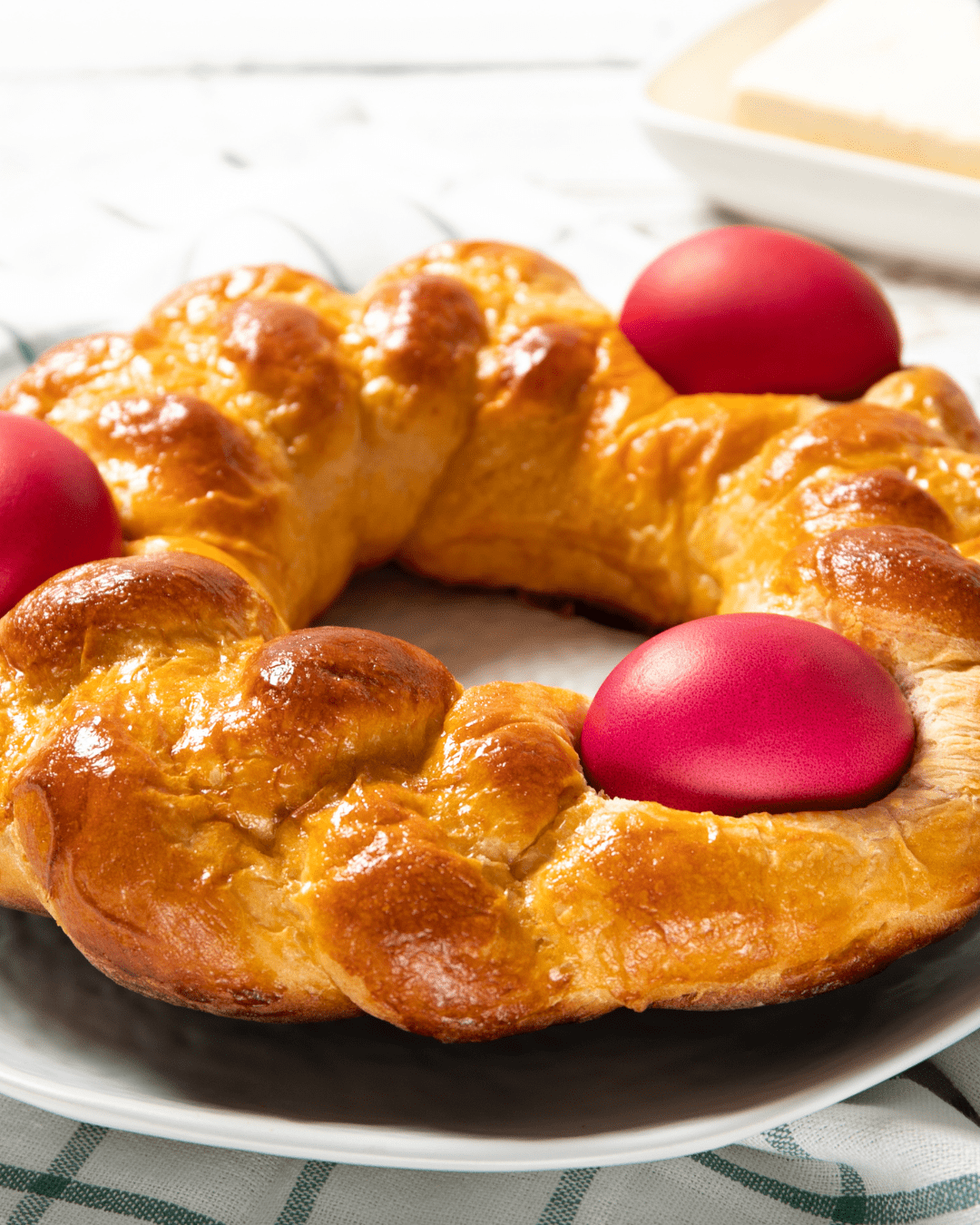From the time I was a little child, perched on a stool in my grandmother’s kitchen, to the present day, as I continue this tradition with my children, the process of kneading the dough, dyeing the eggs, and watching this special bread take form has been nothing short of magical. This Easter Bread with Eggs is more than a recipe; it’s a tapestry of memories, a symbol of renewal, and a testament to the enduring bonds of family and tradition.
Table of Contents
How to make Easter Bread with Eggs
Easter Bread with Eggs is a traditional festive bread made and eaten around Easter, especially in many European cultures. It’s a sweet, soft, slightly yeasty bread that’s often braided or shaped into a wreath or ring, with colorful dyed eggs nestled into the dough before baking.
Ingredients:
For the bread:
- 4 to 5 cups all-purpose flour
- 1/2 cup sugar
- 1 teaspoon salt
- 1 package active dry yeast (about 2 1/4 teaspoons)
- 2/3 cup milk (whole or 2%)
- 5 tablespoons unsalted butter
- 2 large eggs
- Zest of 1 orange (optional for a citrusy flavor)
- 1/2 teaspoon vanilla extract (optional)
For the egg decoration:
- 5 raw eggs
- Food coloring and vinegar (for dyeing the eggs, if desired)
For the glaze (optional):
- 1 cup powdered sugar
- 2 tablespoons milk
- 1/2 teaspoon vanilla extract (optional)
- Sprinkles or colored sugars (for decoration)
Instructions:
Step 1: Prepare the Dough
- In a large mixing bowl, combine 1 1/2 cups flour with the sugar, salt, and yeast.
- In a small saucepan, heat the milk and butter until the butter melts and the mixture is warm (not hot).
- Add the warm milk and butter to the dry ingredients along with the eggs, orange zest, and vanilla extract. Mix until smooth.
- Gradually add more flour, a bit at a time, until a soft dough forms. You might not need all the flour, or you may need a little more – the dough should be soft but not sticky.
- Turn the dough out onto a floured surface and knead for about 8-10 minutes or until smooth and elastic.
- Place the dough in a greased bowl, cover it with a clean towel, and let it rise in a warm place until it has doubled in size, about 1-2 hours.
Step 2: Dye the Eggs (optional)
- While the dough is rising, prepare your dyed eggs if you are using them. Simply dye the eggs as you normally would for Easter using food coloring and vinegar, but do not hard-boil them—they will cook when the bread bakes.
Step 3: Shape the Bread
- Once the dough has risen, punch it down and turn it out onto a floured surface.
- Divide the dough into three equal parts if you are making a braid, or you can create rolls or a wreath.
- For a braid, roll each part into a long strand and braid them together, tucking the ends under. Place the braid on a greased baking sheet.
- Gently nestle the dyed, raw eggs into the dough, spacing them out evenly.
Step 4: Second Rise
- Cover the shaped dough with a towel and let it rise for another hour until puffed up.
Step 5: Bake
- Preheat your oven to 350°F (175°C).
- Bake the bread for about 30-35 minutes or until it is golden brown and the internal temperature reads 190°F (88°C) on a thermometer.
- Remove from the oven and let it cool on a wire rack.
Step 6: Glaze and Decorate
- If you’re adding a glaze, whisk together the powdered sugar, milk, and vanilla until smooth.
- Drizzle the glaze over the cooled bread and decorate with sprinkles or colored sugars if desired.
Tips:
- Temperature Control: Make sure that the milk and butter mixture is warm to the touch but not hot, as too much heat can kill the yeast.
- Dough Consistency: If your dough is too sticky, add flour one tablespoon at a time. If it’s too dry, add a teaspoon of milk at a time until it reaches the right consistency.
- Egg Safety: Since the eggs cook in the oven with the bread, do not over-dye them with excessive handling; they should remain raw until baked.
- Dough Rising: For the best rise, place the dough in a draft-free area. A turned-off oven with the light on can be a great spot.
- Baking Evenness: If the top of your bread is browning too quickly while baking, tent it loosely with aluminum foil to prevent burning.
Ingredients Substitutes
Creating Easter Bread with Eggs can be a joyful baking project for the Easter season, but understanding how to substitute ingredients can be essential, especially if you’re dealing with allergies, dietary preferences, or just find yourself short on certain items.
1. Flour
- Gluten-Free Option: If you have a gluten intolerance, replace regular flour with a gluten-free all-purpose blend. Make sure the blend includes xanthan gum, which helps replicate the texture and elasticity of gluten.
- Whole Wheat Flour: For a healthier option, you can substitute up to half of the white flour with whole wheat flour, but expect a denser Easter Bread with Eggs.
2. Sugar
- Honey or Maple Syrup: To enhance the bread’s flavor with natural sweetness, replace sugar with an equal amount of honey or maple syrup. Reduce any liquid in the recipe by 3 tablespoons per cup of syrup used.
- Coconut Sugar: This can replace white sugar in a 1:1 ratio and offers a lower glycemic index.
3. Milk
- Non-Dairy Milks: Almond, soy, rice, or oat milk can easily replace cow’s milk in a 1:1 ratio. Use unsweetened varieties to control the sweetness of the Easter Bread with Eggs.
- Lactose-Free Milk: This is an excellent alternative for those who are lactose intolerant.
4. Butter
- Vegan Butter: A straightforward substitute for dairy butter if you’re catering to vegans or those with dairy allergies.
- Coconut Oil: To avoid a coconut flavor, use refined coconut oil as a butter substitute; it works well in the same quantity as butter.
5. Eggs (for the dough)
- Applesauce: To replace one egg, use ¼ cups of unsweetened applesauce. This substitution works well in sweet breads.
- Flaxseed Meal: Mix one tablespoon of flaxseed meal with three tablespoons of water and let it sit for a few minutes until it becomes gelatinous. This mixture can replace one egg.
- Yogurt or Buttermilk: A quarter cup of yogurt or buttermilk can substitute for one egg, adding a slight tanginess to the bread.
6. Yeast
- Instant Yeast: If you have only active dry yeast, you can use it in place of instant yeast by activating it first in warm water. Generally, use 25% more active dry yeast than the recipe calls for instant yeast.
- Baking Powder and Bicarbonate of Soda (Baking Soda): If yeast is unavailable, use a combination of baking powder and bicarbonate of soda. Use three times the amount of baking powder as yeast is called for in the recipe. Please note that this can alter the texture and taste slightly.
7. Dried Fruit (Add-ins)
- Alternatives: If you don’t have or don’t like the specific dried fruits like raisins or currants suggested in a recipe, consider substituting them with dried cranberries, chopped dates, or chopped dried apricots.
8. Nuts (Add-ins)
- Seed Alternatives: If allergies are a concern, replace nuts like almonds or walnuts with seeds such as pumpkin or sunflower seeds. These will add a similar crunch without the allergens.
9. Spices
- Mix and Match: If your recipe calls for spices that you don’t have, feel free to experiment with what you do have. Nutmeg can substitute for mace, allspice can work instead of cloves, and a mix of cinnamon and ginger can replace cardamom.
Final Thoughts
Combining Easter Bread with Eggs with these suggested accompaniments will create a visually appealing and deliciously satisfying Easter feast that your family and friends are sure to remember.
More Bread Recipes:

Ingredients
For the bread:
- 4 to 5 cups all-purpose flour
- 1/2 cup sugar
- 1 teaspoon salt
- 1 package active dry yeast
- 2/3 cup milk (whole or 2%)
- 5 tablespoons unsalted butter
- 2 large eggs
- Zest of 1 orange
- 1/2 teaspoon vanilla extract
For the egg decoration:
- 5 raw eggs
- Food coloring and vinegar
For the glaze (optional):
- 1 cup powdered sugar
- 2 tablespoons milk
- 1/2 teaspoon vanilla extract
- Sprinkles or colored sugars
Instructions
Step 1: Prepare the Dough
- In a large mixing bowl, combine 1 1/2 cups flour with the sugar, salt, and yeast.
- In a small saucepan, heat the milk and butter until the butter melts and the mixture is warm (not hot).
- Add the warm milk and butter to the dry ingredients along with the eggs, orange zest, and vanilla extract. Mix until smooth.
- Gradually add more flour, a bit at a time, until a soft dough forms. You might not need all the flour, or you may need a little more – the dough should be soft but not sticky.
- Turn the dough out onto a floured surface and knead for about 8-10 minutes or until smooth and elastic.
- Place the dough in a greased bowl, cover it with a clean towel, and let it rise in a warm place until it has doubled in size, about 1-2 hours.
Step 2: Dye the Eggs (optional)
- While the dough is rising, prepare your dyed eggs if you are using them. Simply dye the eggs as you normally would for Easter using food coloring and vinegar, but do not hard-boil them—they will cook when the bread bakes.
Step 3: Shape the Bread
- Once the dough has risen, punch it down and turn it out onto a floured surface.
- Divide the dough into three equal parts if you are making a braid, or you can create rolls or a wreath.
- For a braid, roll each part into a long strand and braid them together, tucking the ends under. Place the braid on a greased baking sheet.
- Gently nestle the dyed, raw eggs into the dough, spacing them out evenly.
Step 4: Second Rise
- Cover the shaped dough with a towel and let it rise for another hour until puffed up.
Step 5: Bake
- Preheat your oven to 350°F (175°C).
- Bake the bread for about 30-35 minutes or until it is golden brown and the internal temperature reads 190°F (88°C) on a thermometer.
- Remove from the oven and let it cool on a wire rack.
Step 6: Glaze and Decorate
- If you’re adding a glaze, whisk together the powdered sugar, milk, and vanilla until smooth.
- Drizzle the glaze over the cooled bread and decorate with sprinkles or colored sugars if desired.
